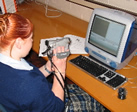Secondary 3
In this activity, Year 9 pupils explored the Children and Young People Talking website to debate the key question: ‘What do people from two religions say about belief in God?’. This PCfRE (Professional Council for Religious Education) resource is an online, interactive and moderated database of young people’s responses to 11 religious and spiritual questions.
The database is open to anyone to contribute their ideas, and contributors are identified only by age, gender and religious affiliation. All contributions are read and edited by an RE specialist before going live, and comments which are impossible to read or understand, or which are libellous or offensive in any way, are deleted.
The pupils worked in the school’s 16-station ICT suite to produce a record of their findings and personal observations in which they identified and explained:
the main beliefs expressed by each religion
the differences between them
differences between members of the same religion
their own views and questions about belief in God.
As a starter activity, the teacher selected from the website 10 statements about belief in God made by young people from a variety of faith and non-faith standpoints. The pupils then completed a diamond ranking exercise to put the statements in order, from those they most agreed with to those they most disagreed with.
The main activity began with the pupils exploring the responses they gave in the starter exercise. They also thought about questions they would like to ask about belief in God. The pupils discussed their ideas and recorded a selection of their comments on the class board.
The teacher then used a digital projector and internet-linked computer to introduce the Children and Young People Talking website and database, indicating the key aspects of the resource which pupils would be working with during the lesson:
a questionnaire relating to religious and spiritual questions
comments and beliefs contributed by young people
the opportunity to add their own considered thoughts.
This quick tour of the site ensured that all pupils accessed the database quickly, located the information they needed efficiently, and remained on task.
After the introduction, the teacher moved on to show the class how to conduct a simple search, focusing on Islam and Hinduism, the two religions being studied. Working in pairs, the pupils completed a search quickly and efficiently, seeking the views of secondary-age Hindus and Muslims about belief in God. Some pupils independently identified further search criteria to inform their response:
Are there differences between boys’ and girls’ responses?
How are the responses of pupils of primary age (8-10 years) different from those of older pupils? What factors might account for this?
In which religion is there evidence of greater diversity of opinion? What reasons might there be for this?
The teacher prompted the class with further questions, encouraging them to consider the source and accuracy of data presented, and the legitimacy of any conclusions drawn from it. For example:
How representative of Hindu and Muslim beliefs (or any other religious or non-religious standpoints represented) are the statements in the database likely to be?
What effect might the fact that the database is moderated have on the data available?
In the subsequent plenary, pupils composed their own statement about belief in God and submitted it to the database.
During this activity, pupils:
described key beliefs in two religions
explained with knowledge and understanding how key beliefs make a difference to people’s lives
demonstrated awareness of the diversity within and between religions
made an informed response to religious beliefs and commitments, explaining their own answers to religious questions.Used in the way outlined here, this resource can enable pupils to reach levels 4-6 of the national expectations for RE.
How ICT enhanced teaching and learning
By using ICT, pupils accessed and responded to authentic comments on a range of topics from young people with widely differing backgrounds. They searched a large amount of data to find relevant information - which, using traditional methods, would not have been possible within the time available.
The database is a moderated resource to which the pupils added their own views and opinions in response to the question set at the beginning of the activity. These two points encouraged the pupils to respect the comments on the database and to consider carefully their own comments before submitting them. More able pupils also reflected on the implications of moderation. They were encouraged to view the source and nature of the data critically.
Links and Resources
Suggestions for classroom use and details of copyright are available from the Children and Young People Talking website. previous 1 2 printer friendly version of this page

